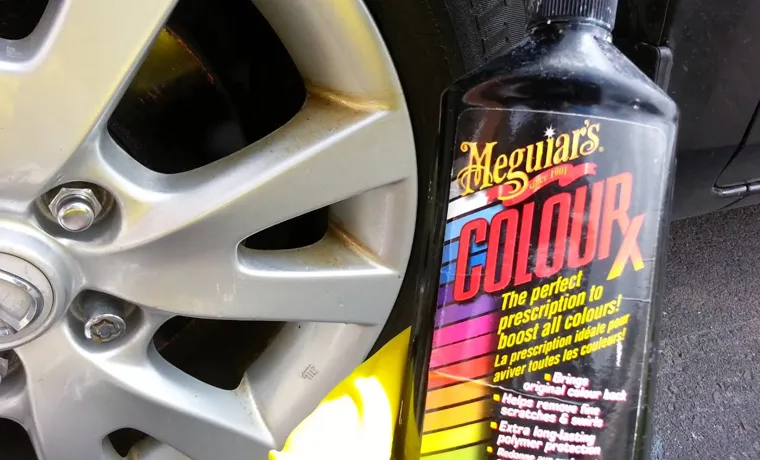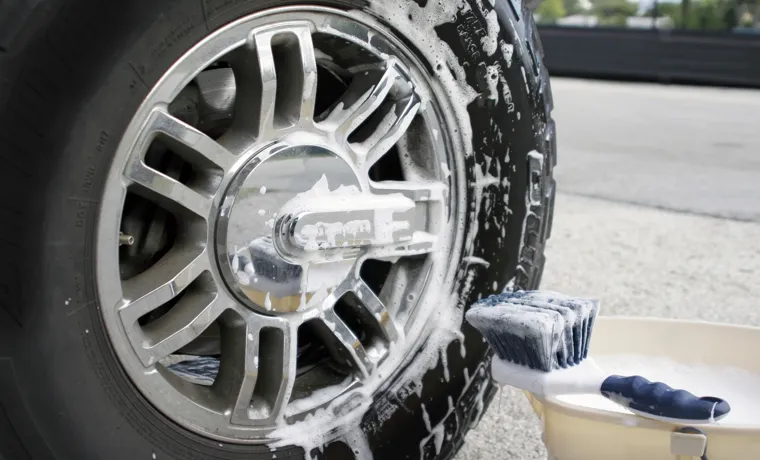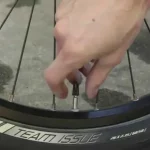Are your tire rims looking shabby and rusty? Not to worry, as there are ways to revive them back to their original shine. Rust on tire rims is a common problem that car owners encounter due to exposure to moisture, road salt, and debris. Rusty rims not only detract from the overall appearance of a vehicle but can also lead to further damage if left unchecked.
Removing rust from tire rims is a crucial step in maintaining their longevity and appearance. This blog will explore various methods for removing rust and restoring your tire rims to their former glory. So, let’s get started and give your car the upgrade it deserves!
Table of Contents
Understanding the Causes of Rust on Tire Rims
If you’ve noticed rusty tire rims on your vehicle, don’t panic. Rust on tire rims happens due to a variety of reasons, but it’s something that can be dealt with quickly and easily. One of the main causes of rust on tire rims is exposure to harsh weather conditions such as rain, snow, and salt.
The water that accumulates on the rims reacts with the iron in the metal and begins to rust over time. Another culprit that causes rust on tire rims is brake dust. This is a common natural occurrence that happens when your brakes are in use, and the friction between your brakes and tires results in dust accumulation.
This brake dust is corrosive, which causes it to slowly eat away at the rim’s protective layer, exposing the metal to the elements and leading to rust formation. Fortunately, there are easy ways to clean rust off tire rims and prevent further rust formation. So, take good care of your tire rims to prevent rust formation in the first place, and if it does occur, take care of it quickly to avoid any long-term damage.
Environmental Exposure
If you’re noticing rust forming on your tire rims, chances are it’s from exposure to the environment. Environmental factors such as road salt, moisture, and air pollution can all contribute to the formation of rust. Salt used to de-ice roads during the winter can create a corrosive mixture when it comes into contact with moisture on your rims.
This combination starts to eat away at the metal and ultimately forms rust. Additionally, moisture and air pollution can cause rust to form on your rims over time. It’s important to stay vigilant and regularly clean your rims to prevent rust from forming.
Using a protective coating can also help prevent rust and keep your rims looking like new. Keep in mind that the earlier you catch rust forming on your rims, the easier it is to clean and prevent further damage. Don’t let rust ruin your ride – take steps to protect your rims today.

Brake Dust
Brake Dust If you are a car enthusiast, you must have come across the frustrating issue of rust on tire rims. You invest so much money and time in keeping your car in pristine condition, and yet you still end up with unsightly corrosion on your tire rims. Many car owners blame the quality of their rims, but the truth is that the main culprit is brake dust.
Brake dust is a combination of metallic particles that are released every time you apply your brakes. These particles are highly corrosive and can quickly rust your tire rims if not cleaned off regularly. The good news is that there are ways to prevent brake dust buildup, such as using low-dust brake pads and regularly washing your car.
By taking these measures, you can prolong the life of your tire rims and keep your car looking great for longer.
Salt and Road Debris
If you’re wondering why your tire rims have rust, two of the most common culprits are salt and road debris. Salt can cause rust to form on rims, especially during winter months when roads are salted to prevent ice build-up. The salt can easily corrode the metal, leading to rust formation.
Similarly, road debris such as dirt, mud, and rocks can cause rust to form on rims over time if they’re left on for too long. The debris can scratch and damage the rims, making them more susceptible to rust. To prevent rust formation, it’s important to regularly clean your rims, especially during the winter months when excess salt is present on the roadways.
Additionally, parking in a covered area or using rim covers can help protect rims from road debris. By taking these simple steps, you can ensure that your tire rims stay rust-free and in top condition for years to come.
Materials Needed
If you’re tired of looking at rusted tire rims and want to restore them back to their original glory, you’re in the right place. Cleaning rust off tire rims might seem like a daunting task, but it’s actually quite simple with the right materials. To get started, you’ll need a few items, including steel wool, a wire brush, a sanding block or sandpaper, gloves, and a rust remover solution.
Once you have these materials, you’ll be one step closer to achieving a polished and rust-free tire rim. When it comes to choosing a rust remover solution, you have a few options. Some popular choices include vinegar, baking soda, and commercial rust removers.
Vinegar and baking soda are great eco-friendly options, but they may require more elbow grease to remove the rust. On the other hand, commercial rust removers are specifically designed to do the job quickly and efficiently, but they may contain harsh chemicals. Regardless of which option you choose, be sure to follow the instructions carefully and wear gloves to protect your hands.
With the right materials and some patience, you can easily clean rust off tire rims and enjoy a smooth, shiny surface once again. So roll up your sleeves, put on some gloves, and get ready to give your tire rims a new lease on life!
Sandpaper
When it comes to prepping wood or other materials for painting or finishing, sandpaper is an essential tool to have on hand. To get started, you’ll need a few supplies. First, you’ll need sandpaper of various grits, depending on the task at hand.
Coarse grits (generally between 40 and 60) are perfect for removing heavy material, while finer grits (between 120 and 180) are better for smoothing surfaces. You’ll also need a sanding block to hold the sandpaper and provide even pressure. If you’re working on a large project, a power sander can be helpful but not required.
When sanding, make sure to apply even pressure and keep the sandpaper moving in a consistent direction. Don’t forget to wear a mask and eye protection to avoid inhaling any dust particles. With the right materials and technique, sanding can be a quick and easy way to prepare your materials for the finishing touches.
Steel Wool
If you’re looking to add steel wool to your supply kit, there are a few materials that you will need to get started. Firstly, you’ll need to purchase a pack of steel wool, which can be found at most hardware stores. It’s important to note that there are different grades of steel wool, ranging from extra-coarse to ultra-fine, so consider the purpose of your project before selecting a grade.
Additionally, you’ll want to make sure you have a pair of gloves to protect your hands and a pair of scissors to cut the steel wool. Some projects may require additional materials such as a wire brush or sandpaper to prepare the surface before applying the steel wool. With these materials in hand, you’re ready to start experimenting with steel wool in your DIY projects.
From creating a vintage finish on wood furniture to making sparkly starry night photography, the possibilities are endless!
Rust Dissolver
If you have a rusted metal surface that you want to restore, using a rust dissolver is the ideal solution. The materials needed for rust dissolving depend on the type of product you are using. Most rust dissolvers require the use of safety gear such as gloves, goggles, and masks due to their harsh chemical properties.
A standard rust dissolver kit usually includes a bottle of rust dissolver solution, a wire brush, a scouring pad, and a cloth. The solution contains powerful chemicals that break down the rust particles and loosen them from the metal surface. You can apply the rust dissolver using a spray bottle, brush, or by soaking the rusted item in the solution.
Follow the manufacturer’s instructions carefully to prevent damage to the metal surface or injury to yourself. Once the rust is fully dissolved, use the wire brush or scouring pad to gently scrub the metal surface and remove any remaining rust particles. Finally, wipe the surface clean using the cloth provided in the kit.
With the right materials and careful application, rust dissolver can restore your metal surfaces to their former glory in no time.
Protective Gloves
When it comes to protective gloves, choosing the right material can make all the difference in ensuring your safety. Whether you’re working with chemicals, sharp objects, or extreme temperatures, it’s important to choose gloves made from materials that are durable, comfortable, and provide the necessary level of protection. Among the most common materials used for protective gloves are latex, nitrile, neoprene, vinyl, and polyethylene.
Latex gloves offer great protection against many chemicals and are comfortable to wear, but may not be the best choice for those with latex allergies. Nitrile gloves, on the other hand, are suitable for a wide range of applications and offer excellent puncture resistance. Vinyl gloves are a good option for those who need gloves for light-duty tasks, while neoprene gloves are ideal for those working with chemicals that require a high level of protection.
Polyethylene gloves are a cost-effective option for those who need disposable gloves for short-term use. Ultimately, the choice of material will depend on the specific type of work you’ll be doing and the level of protection you require. So, when it comes to selecting protective gloves, make sure to consider the materials carefully to keep yourself safe on the job.
Cleaning process
If you’re looking to restore the look of your tire rims, removing rust is the first step. Thankfully, it’s a relatively simple process that you can do at home. First, gather your supplies – you’ll need gloves, a wire brush, sandpaper, rust remover solution, and a polishing compound.
Start by brushing off any loose dirt or debris from the rim with the wire brush. Then, sand the affected areas with sandpaper until the rust is removed. Next, apply the rust remover solution and let it sit for the recommended amount of time.
Wipe away the solution and rinse the rim with water. Once the rim is fully dry, apply the polishing compound to bring back its shine. It’s important to note that some rust may be too deep to remove completely, but this process should improve the overall appearance of your tire rims.
With a little bit of elbow grease, your rims will be looking as good as new!
Preparation
The cleaning process is a necessary and important step in preparing for any project. Whether you’re cleaning a room in your house or a workspace for a project, the first step is to declutter. This means getting rid of anything that you don’t need, including trash, broken or unused items, and anything that’s just taking up space.
Once you’ve decluttered, you can start to clean. Dust and wipe down surfaces, vacuum carpets and floors, and make sure everything is tidy and organized. Don’t forget about the nooks and crannies, as dirt and dust can often accumulate there.
Organizing your cleaning supplies beforehand can make the process smoother and more efficient. This includes having the right cleaning products for the specific surfaces you’re cleaning. A clean and organized workspace or living area can help increase productivity and decrease stress.
By taking the time to properly clean and prepare, you’ll set yourself up for success in any project or activity that follows.
Sand the Rim Surface
Sandpaper is a great ally when it comes to restoring the wood on the rim of a vehicle. Begin by lightly sanding the surface, making sure you remove any dirt or debris. Once that’s done, you can use a finer grit sandpaper to smooth out the surface and remove any old finish that may be present.
Make sure you sand in the direction of the wood grain, as this will create a smoother and more consistent surface. Once you’ve finished sanding, clean the surface with a damp cloth to remove any remaining dust or debris. This will ensure that the surface is clean and ready for the next step in the restoration process.
Overall, sanding the rim surface is an essential part of the cleaning process, as it creates a smooth and even surface for the next steps to build upon.
Apply Rust Dissolver
Cleaning Process, Rust Dissolver When dealing with rust, it’s important to start with a clean surface before moving on to repairs or new coatings. That’s where rust dissolver comes in. This powerful solution is designed to break down and remove even the most stubborn rust stains.
Applying rust dissolver is a straightforward process, but it’s important to follow the instructions carefully to ensure the best results. First, clean the surface you’ll be treating with a wire brush and remove any loose rust particles. Then, apply the rust dissolver according to the instructions on the bottle.
Be sure to wear protective gloves and eyewear, as the solution can be hazardous if it comes into contact with your skin or eyes. Once you’ve applied the rust dissolver, give it time to work its magic. The length of time will vary depending on the brand and the severity of the rust, but typically it can take anywhere from a few minutes to several hours.
Once the rust dissolver has done its job, you can wipe away the residue with a clean cloth and rinse the surface with water. Your surface will be clean and ready for whatever repairs or coatings you have planned. With this simple process, you’ll be able to tackle rust stains with ease and get back to working on your projects in no time.
Scrub with Steel Wool
Cleaning process, Scrub with Steel Wool When it comes to deep cleaning, Scrub with Steel Wool is a great option. If you find yourself struggling with stubborn stains or grime, this method can work wonders. However, it’s important to use steel wool wisely, as it can scratch delicate surfaces.
For instance, if you have stainless steel appliances, be sure to use a gentler method instead. Additionally, make sure you’re using a fine grade of steel wool, as coarse grades can be too abrasive. Overall, Scrub with Steel Wool is an excellent option for tough cleaning jobs, but it’s important to use caution and choose the appropriate materials for the job.
With a little bit of care, you can achieve a sparkling clean home in no time!
Wash and Dry
The cleaning process for wash and dry can be a bit tricky. Before washing your clothes, ensure that all pockets are empty, and all zippers are zipped up. Sorting your laundry by color can also help to avoid any color bleeding disasters.
For white clothes, use hot water to eliminate stains and to brighten them up. On the other hand, for colored clothes, use cold water and a mild detergent to prevent colors from fading. When it comes to drying your clothes, it’s best to follow the instructions on the clothing label.
Delicate fabrics like silk and wool should be air-dried, while other fabrics like cotton and linen can be tumble dried. In some cases, clothes may shrink if exposed to high heat, so it’s best to use a lower heat setting or air-dry them altogether. By following these simple steps, you can ensure that your clothes are properly washed and dried, maintain their color and fabric quality, and last in your wardrobe for longer.
Preventive Measures to Keep Tire Rims from Rusting
If you want to keep your tire rims from rusting, there are several preventive measures you can take. Firstly, keep your rims clean and dry. Dirt, grime, and water can accumulate on your rims, leading to rust formation over time.
Cleaning them regularly with mild soap and water, followed by a thorough drying with a soft cloth, will help prevent this. Additionally, you can apply a coat of wax or protective sealer to your rims, which will create a barrier between the metal and any moisture or corrosive substances. If you do notice rust forming on your rims, you can try to remove it with a gentle rust remover or a mixture of baking soda and water.
Just remember to rinse and dry the rims thoroughly afterwards. By following these simple steps, you can keep your tire rims looking great and functioning well for years to come.
Waxing the Rim Surface
Preventive measures Other keywords used organically: tire rims, rusting, waxing, rim surface Tire rims can make or break the entire look of your vehicle, but they are also more prone to rusting due to exposure to various elements on the road. To prevent this, waxing the rim surface can be an excellent preventive measure. Car wax creates a barrier between the rim surface and harmful environmental elements such as dirt, salt, and moisture, reducing the chance of rust formation.
Before applying wax, make sure to thoroughly clean the rims to remove any dirt, grime, or rust already present. Once the rims are cleaned and dried, apply the wax using a soft cloth, spreading it evenly across the entire surface. Let it dry and then buff the rims with another clean, dry cloth.
This process should be repeated at least every three months or more frequently depending on the driving conditions. With regular waxing, you can maintain a shiny and rust-free rim surface for a long time. Remember, prevention is always better than cure, so take care of your tire rims before they start to rust.
Protective Coating
One of the most annoying things we often experience as car owners is to see our tire rims dull and rusty. Thankfully, there are several ways we can prevent rust and keep our rims looking shiny and new. One of the best preventive measures against rusting is to apply a protective coating on the rims.
This involves cleaning and sanding the surface of the rim to remove any dirt or rust particles, then applying a special coating that acts as a barrier against corrosion. The coating not only protects the wheel from rust but also gives it a glossy finish that enhances the overall look of our car. It is essential to choose the correct type of coating based on the type of wheel and the automobile’s make and model.
For best results, it’s advisable to seek the services of a professional to ensure the coating is applied properly and lasts for an extended period. By utilizing a protective coating, we can enjoy rust-free band rims for a long time, ensuring our investment in our vehicle is protected.
Conclusion
In conclusion, cleaning rust off tire rims can be a challenging task, but with the right tools and techniques, you can make those rims shine like new again. Don’t let rust slow you down or dull your ride – take on the challenge with a smile and a can-do attitude. Remember, a little elbow grease goes a long way, and prevention is key – so keep those rims dry and protected to keep rust at bay.
Happy cleaning!”
FAQs
What causes rust to form on tire rims?
Rust forms on tire rims due to exposure to moisture, salt, and oxygen over time.
Is it safe to drive with rusted tire rims?
It is not recommended to drive with rusted tire rims as it can compromise the structural integrity of the rims and increase the risk of a tire blowout.
Can rusted tire rims be repaired?
Yes, rusted tire rims can be repaired by sanding down the affected area and applying rust-resistant paint or coating.
What is the best way to prevent rust from forming on tire rims?
The best way to prevent rust on tire rims is to regularly clean and dry them and apply a protective coating of wax or sealant.
Can household cleaning products be used to remove rust from tire rims?
Yes, household cleaning products such as vinegar, baking soda, and lemon juice can be used to remove rust from tire rims.
Is it necessary to replace rusted tire rims?
In some cases, it may be necessary to replace rusted tire rims if the damage is extensive or affects the structural integrity of the rim.
Can professionals help in cleaning and repairing rusted tire rims?
Yes, professionals at auto repair shops specialize in cleaning and repairing rusted tire rims and can ensure the safety and longevity of the rims.



